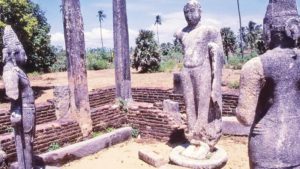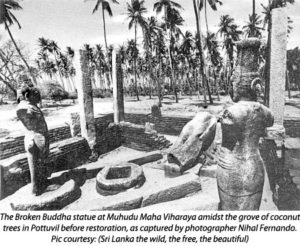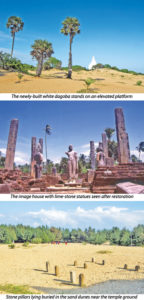The legendary photographer, the late Nihal Fernando’s stunning image narrates the tale of the vanishing glory of Muhudu Maha Viharaya
Life brings tears, smiles and memories that last forever. All it takes is a picture to bring back a thousand memories. Our subject this time is the Muhudu Maha Viharaya in Pottuvil where time stands still, where the dust of the royal past never settles. How about reliving an age gone by?
Now, you can take a step back in time and enjoy the fascinating past. Photographic records of a bygone era capture a slice of history and become part of our cultural heritage. Nihal Fernando’s timeless photo of Muhudu Maha Viharaya, brings alive the past in minute detail. A picture is worth a thousand words, they say. The photo, with a vast grove of coconut trees amidst the ancient ruins of Muhudu Maha Viharaya narrates the tale of today’s despair in a telling manner.
Though there is no dearth of evidence on an era gone by in Muhudu Maha Viharaya, this picture is perhaps the first of its kind. Fernando might have taken it in the 60s or 70s which shows how the temple ground occupies the grove of coconut trees near the sea coast off Pottuvil. Just about everything in Pottuvil is contained in this photo. And what’s more, it solves many a jigsaw puzzle.
The photo presents a grove of coconut trees in front of the temple ruins which belonged to the temple and is now a bustling housing scheme. Similarly, one gets to see government buildings close to the sea coast near the temple. This photo is one of the best ways to show the picture of Muhudu Maha Viharaya in an age gone by and today the temple is facing a land dispute.
Photographer Nihal Fernando embarked on a voyage across the length and breadth of the country with camera in hand in an era of black and white or monochrome photography (sixties and seventies). He captured historic sites, monuments, people and wildlife, travelling freely everywhere in the country which was an obvious advantage during the post-independence but pre-war period.
I am an avid admirer of this great photographer and the stunning photo was culled from one of his pictorial books –‘The Wild- The free – The beautiful’- published in 1988.
At the Muhudu Maha Viharaya, he captured this breathtaking candid shot that captures the solitude and silence of the environs in a bygone era which is evidence of today’s encroachment of temple land by nearby villagers.
As Nihal Fernando did, I too visited Muhudu Maha Viharaya on several occasions during my journeys to the East. I visited it after the Peace Accord (MoU) was signed by the Government and the LTTE in 2000 and also during my visits to the Yala East National Park.
During my second visit in 2008, I stayed overnight at the temple to view the breathtaking sunrise over Arugam Bay. At that time, Ven. Kataragama Sirirathana Thera was the resident monk of the Viharaya. He told me that he rarely gets the Dana (alms) twice a day since the Sinhala Buddhis community is very small in Pottuvil. Sometimes he depended on the Buddhist pilgrims who visited the temple.
Ven. Udalamaththe Ratnapriya Thera is the present resident monk of the temple. He said that in the past the temple owned 30 acres of land, but due to encroachment by the villagers the land has shrunk to a very small area. He said there are around 17 Sinhala families who live around Pottuvil and offer Dana (alms) to the temple. Sometimes, the soldiers of the nearby Army camp provide meals while some financial contributions are provided by Buddhist pilgrims who visit the site. Not far away from the township of Pottuvil lies a tiny hamlet amidst bustling concrete block houses. Scattered here and there on the elevated ground were a few stone pillars and a torso of the standing statue of the Buddha along with limbless limestone -cut statues believed to be a Mahayanist Buddhist site. In the bushes of the sand dunes generated by the waves are a few stone pillars. A few yards away from this spot on the sandy beach facing the sea was a heap of broken bricks strewn here and there. Some stone pillars were partially submerged in the sand. A glistering newly-built white dagoba stands majestically on the elevated ground in the coast. Several brickbats and terracotta sculptures have been discovered in the process of excavation.
The name given to this antique spot locally is Muhudu Maha Viharaya. According to a folk tale, after the Royal wedding of Princess Vihara Maha Devi, daughter of King Kelani Tissa and King KavanTissa of the Rohana kingdom, the Royal couple made their maiden visit (probably on their honeymoon) to this spot. Kelaniya was submerged by the sea due to a natural disaster. Princess Devi the daughter of the King of Kelaniya was cast away to sea in a vessel and the princess washed ashore near the Muhudu Maha Vihara in Pottuvil. To commemorate that occasion, the king is said to have built these dagobas and the image house which are now almost in ruins and hardly discernible.
When Nihal Fernando visited the site, the limestone cut-Buddha statue that was lying prone on the ground has since been restored. This fallen Buddha statue has now been restored to its original standing position by the Department of Archaeology. However, the stunning photo that Nihal Fernando captured many decades ago is a perfect picture of Muhudu Maha Viharaya even to date.
source:
http://www.sundayobserver.lk/2019/09/08/reflections/going-back-time-through-timeless-frame



 Arugam Forum
Arugam Forum Arugam Photo Galleries on Picasa
Arugam Photo Galleries on Picasa Old Website
Old Website Press Coverage
Press Coverage Surf Forecast for Arugam Bay
Surf Forecast for Arugam Bay
0 Responses to “Muhudu Maha Viharaya”